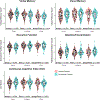Cognitive and Cerebrospinal Fluid Alzheimer's Disease-related Biomarker Trajectories in Older Surgical Patients and Matched Nonsurgical Controls
- PMID: 38324729
- PMCID: PMC11003848
- DOI: 10.1097/ALN.0000000000004924
Cognitive and Cerebrospinal Fluid Alzheimer's Disease-related Biomarker Trajectories in Older Surgical Patients and Matched Nonsurgical Controls
Abstract
Background: Anesthesia and/or surgery accelerate Alzheimer's disease pathology and cause memory deficits in animal models, yet there is a lack of prospective data comparing cerebrospinal fluid (CSF) Alzheimer's disease-related biomarker and cognitive trajectories in older adults who underwent surgery versus those who have not. Thus, the objective here was to better understand whether anesthesia and/or surgery contribute to cognitive decline or an acceleration of Alzheimer's disease-related pathology in older adults.
Methods: The authors enrolled 140 patients 60 yr or older undergoing major nonneurologic surgery and 51 nonsurgical controls via strata-based matching on age, sex, and years of education. CSF amyloid β (Aβ) 42, tau, and p-tau-181p levels and cognitive function were measured before and after surgery, and at the same time intervals in controls.
Results: The groups were well matched on 25 of 31 baseline characteristics. There was no effect of group or interaction of group by time for baseline to 24-hr or 6-week postoperative changes in CSF Aβ, tau, or p-tau levels, or tau/Aβ or p-tau/Aβ ratios (Bonferroni P > 0.05 for all) and no difference between groups in these CSF markers at 1 yr (P > 0.05 for all). Nonsurgical controls did not differ from surgical patients in baseline cognition (mean difference, 0.19 [95% CI, -0.06 to 0.43]; P = 0.132), yet had greater cognitive decline than the surgical patients 1 yr later (β, -0.31 [95% CI, -0.45 to -0.17]; P < 0.001) even when controlling for baseline differences between groups. However, there was no difference between nonsurgical and surgical groups in 1-yr postoperative cognitive change in models that used imputation or inverse probability weighting for cognitive data to account for loss to follow up.
Conclusions: During a 1-yr time period, as compared to matched nonsurgical controls, the study found no evidence that older patients who underwent anesthesia and noncardiac, nonneurologic surgery had accelerated CSF Alzheimer's disease-related biomarker (tau, p-tau, and Aβ) changes or greater cognitive decline.
Copyright © 2024 The Author(s). Published by Wolters Kluwer Health, Inc., on behalf of the American Society of Anesthesiologists.
Figures



References
-
- Evered LA, Silbert BS: Postoperative cognitive dysfunction and noncardiac surgery. Anesthesia & Analgesia 2018; 127: 496–505 - PubMed
-
- Monk TG, Weldon BC, Garvan CW, Dede DE, van der Aa MT, Heilman KM, Gravenstein JS: Predictors of cognitive dysfunction after major noncardiac surgery. Anesthesiology 2008; 108: 18–30 - PubMed
MeSH terms
Substances
Grants and funding
LinkOut - more resources
Full Text Sources
Medical

